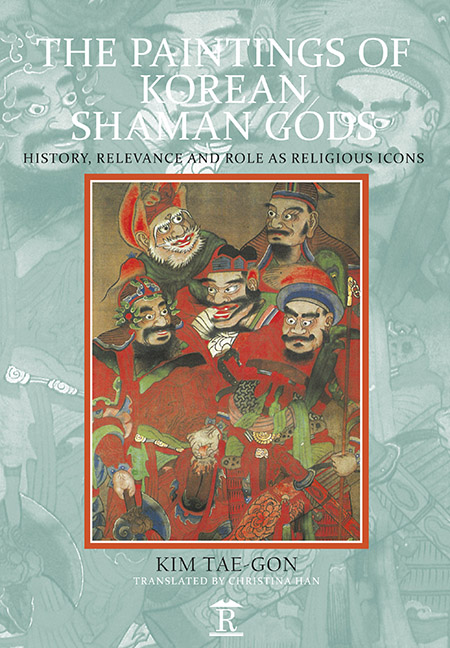Book contents
- Frontmatter
- Contents
- Translator’s Preface
- List of Figures
- List of Plates
- Introduction Visions, Images, Performance: Understanding Korean Shaman Art
- Chapter 1 Paintings Of Korean Shaman Gods
- Chapter 2 The Shaman God Painting As An Icon And Its Artistic Qualities
- Images Of Korean Shaman Gods
- Glossary of Terms
Introduction - Visions, Images, Performance: Understanding Korean Shaman Art
Published online by Cambridge University Press: 30 April 2022
- Frontmatter
- Contents
- Translator’s Preface
- List of Figures
- List of Plates
- Introduction Visions, Images, Performance: Understanding Korean Shaman Art
- Chapter 1 Paintings Of Korean Shaman Gods
- Chapter 2 The Shaman God Painting As An Icon And Its Artistic Qualities
- Images Of Korean Shaman Gods
- Glossary of Terms
Summary
Let's start with two stories that illustrate the origins of shamanism in Korea.
Long ago, there was a king who had many daughters but no son. When the seventh daughter was born, he became greatly incensed. He placed her in a stone box and cast it in a pond. But heaven sent Dragon King who rescued her and took her to heaven. When she was about fourteen years of age, she came down to earth and learned that her mother was critically ill. She travelled far to the Western Sky and brought medicine water and saved her mother. Since then people have visited the princess’ spring of medicine water and listened to the bubbling water as though it were the voice of the princess. The princess was an ancestor of Korean shamans.
Once upon a time, there was a princess who lost her sanity. After being forced out of the palace, she settled in Mt. Namsan in the vicinity of Seoul. She caused much disturbance in Seoul, so the king sent her off with enough food and a maid to the highest peak of Mt. Diamond. At the mountain, the princess had a vision of a crane with blue and white wings coming into her mouth. She closed her mouth tightly so that the crane would be kept in her body. Later she conceived a baby by the crane and gave birth to twin boys. They grew up and became great ministers under her father's rule. Both of them married and each had four girls. All the eight girls became shamans and were sent in different directions to assist the people through their acts of healing and their professions of faith on the spirits. Since then the rejected princess, their grandmother, was honored as an ancestor of shamans.
These stories are two of many legends about the origins of Korean shamanism. Although simple, in them we can identify some of the key characteristics of Korean shamanism. First, those who are deemed to be ancestors of shamans had direct experiences of heavenly spirits, the Dragon King in the first story and the crane in the second story. Second, the shamans trace their origins to the royal lineage, an interesting point since the shamans for a long period in Korean history were considered as outcasts, the lowest class of people.
- Type
- Chapter
- Information
- The Paintings of Korean Shaman GodsHistory, Relevance and Role as Religious Icons, pp. 1 - 12Publisher: Amsterdam University PressPrint publication year: 2018



